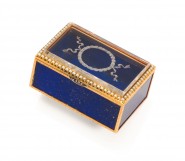Lot #56 - Kaapa (Tjampitjinpa)
-
Auction House:Mossgreen
-
Sale Name:Australian Indigenous & Oceanic Art
-
Sale Date:22 Jul 2014 ~ 6.30pm (Part 1 - Lots 1 - 198)
23 Jul 2014 ~ 2.30pm (Part 2 - Lots 199 - 331) -
Lot #:56
-
Lot Description:Kaapa (Tjampitjinpa)
(circa 1920-1989)
Witchety Grub Dreaming (1973)
synthetic polymer paint on composition board
50.3 x 45.5 cm
signed 'KAAPA JmA' lower verso -
Provenance:Painted at Papunya, Northern Territory; Max Stollznow, Northern Territory (1973/1974); Private Collection, Queensland
-
Notes:Kaapa Tjampitjinpa was an entrepreneurial spirit who enjoyed sourcing his own materials and selling paintings directly to the Europeans living and working at Papunya. This painting was purchased by Pastor Max Stollznow, an evangelical minister who embodied the community's historic connection to the Lutheran mission at Hermannsburg in the early 1970s.1 Witchety Grub Dreaming is clearly conceived and masterfully executed and although seemingly cryptic, its significance would have been immediately evident to Kaapa's peers and countrymen. Its visual clarity belies its multi-layered references to totemic ancestors, the land and events of the Dreaming. It is a brilliantly distilled example of the dot-painting idiom that Kaapa pioneered. The painting's iconographic elements are derived from a tywennge (sacred object) associated with the Witchetty Grub Dreaming. The sets of concentric circles show key totemic sites, while the grubs are rendered literally as small white arcs. Whereas these symbols are traditionally incised into mulga wood or abraded into stone, here they are painted with equivalent care, for Kaapa had a steady hand and an unerring capacity to produce perfectly formed, tight sets of concentric circles. The formal perfection of this work exemplifies Kaapa's ritual maturity and his capacity to evoke symmetry and fine craftsmanship, highly admired attributes of the Anmatyerr aesthetic. Kaapa was a renowned traditional songman and yet he was very much a man of his times and a remarkable innovator. Together with his friend Johnny Warangula and his cousins, Tim Leura and Clifford Possum, Kaapa developed the use of background dots to evoke an attribute of the land in which the key totemic sites are located. This aspect of the narrative may not be apparent in the original tywennge, but is made possible in the new media of acrylic paint. It is likely that the membrane of tri-coloured background dots in this painting refer to the ash-bed resulting from a fire of revenge ignited by Lungkata, (Blue-Tongue Lizard ancestor) at Warlukurlangu (literally 'belonging to fire'). Kaapa has set down a shifting and optically startling pattern to convey the power of the Dreaming emanating from key sites, upon which he has overlaid the contrapuntal arcs of the grubs. John Kean 1 Max Stollznow was the Lutheran Missionary at Papunya in the early 1970s. Kaapa was photographed with fellow artists, Tim Leura Tjapaltjarri, Old Mick Tjakamarra and Geoffrey Bardon outside the church in July 1972, an image which is reproduced of the dedications page of Geoffrey Bardon and James Bardon, Papunya: A Place Made after the Story: The Beginnings of the Western Desert Painting Movement, Melbourne: Miegunyah Press. 2004
-
Estimate:A$8,000 - 12,000
-
Realised Price:
-
Category:Art
This Sale has been held and this item is no longer available. Details are provided for information purposes only.










